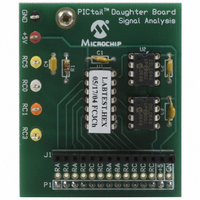AC164120 Microchip Technology, AC164120 Datasheet - Page 22

AC164120
Manufacturer Part Number
AC164120
Description
BOARD SIGNAL ANALYSIS PICKIT
Manufacturer
Microchip Technology
Series
PICtail™r
Specifications of AC164120
Main Purpose
Interface, Signal Analysis
Embedded
Yes, MCU, 8-Bit
Utilized Ic / Part
PICkit™ PICtail™1
Primary Attributes
Real-time Strip Chart, Oscilloscope, Fast Fourier Transformation (FFT)
Secondary Attributes
Histogram
Silicon Manufacturer
Microchip
Core Architecture
PIC
Core Sub-architecture
PIC16
Features
Real-Time Strip Chart, Fast Fourier Transformation
Silicon Core Number
PIC16F
Silicon Family Name
PIC16F6xxx
Rohs Compliant
Yes
Lead Free Status / RoHS Status
Lead free / RoHS Compliant
For Use With
PICkit Flash Starter Kit
Lead Free Status / RoHS Status
Lead free / RoHS Compliant, Lead free / RoHS Compliant
Available stocks
Company
Part Number
Manufacturer
Quantity
Price
Company:
Part Number:
AC164120
Manufacturer:
Microchip Technology
Quantity:
135
Signal Analysis PICtail™ Daughter Board User’s Guide
2.6
DS51476A-page 18
FFT (FAST FOURIER TRANSFORM)
The FFT displays the Fast Fourier Transformation of the data in the frequency domain.
This display is typically used to analyze AC signals or to help locate the source of AC
noise.
FIGURE 2-11:
The size of the data set of the FFT analysis determines the resolution and accuracy of
the FFT. The accuracy is equal to:
Where:
In instances where the input signal is not periodic with respect to the sampling fre-
quency of the converter (as is the case with this tool), windowing algorithms are advan-
tageous when looking at FFT results. The windows that are available with the Signal
Analysis Application are the Blackman, Hamming, Hanning and Rectangular. Basically,
an FFT window is multiplied times the measured signal data set taken during the spec-
ified length of time of the conversion. Typically this multiple reduces the magnitude of
the beginning and end of the sample and consequently minimizing discontinuities seen
with the FFT calculation.
Blackman – Window has a bell-shaped characteristic similar to the Blackman-Harris
window. The peak resolution of this window is not as fine as the Hanning, but the
responses flares out less and the rejection of the sidelobes is better.
Hamming – Window has a bell-shaped characteristic. The initial samples from the
conversion data are multiplied by a small number as are the last samples. With this
window, the side lobes adjacent to the main lobes are lower than the results from the
Hanning Window.
Hanning – Window has a bell-shaped characteristic. The initial samples are multiplied
by zero as well a the latest samples. The samples between the beginning and end are
multiplied with the Hanning bell-shape curve. The side lobes of this window are farther
from main lobe as compared to the Hanning Windows. This window is typically used
for harmonic analysis of continuous time signals as well as random noise.
n = number of converted bits
N = number of data points
FFT Window Selection
FFT Accuracy = (4/(n√N)dB)
FFT DISPLAY
2004 Microchip Technology Inc.












